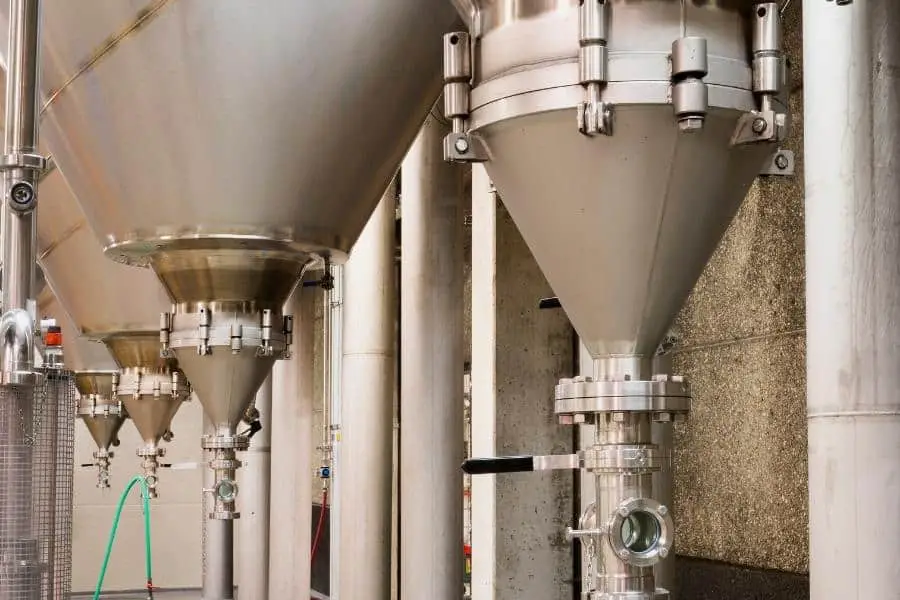If you buy something through a link in our posts, we may get a small share of the sale.
Your conical fermenter is one of the essential equipment you will use in your brewing process, so it is important to keep it clean and sanitized. Knowing how to sanitize your conical fermenter will help you produce great-tasting beer free of contaminants and help prolong your equipment’s life.
Contents
How to Sanitize Conical Fermenter
The best and simple way to clean and sanitize your conical fermenter is to clean it thoroughly and rinse it with hot water. After that, you can sanitize your fermenter by using a sanitizing solution. Ensure you use non-rinse sanitizer for conical fermenters, as it will not leave any residue that can affect the taste of your beer.
You can also clean and sanitize your conical fermenter with white vinegar. Simply fill the vessel with one part water and one part vinegar. Let it sit for about 30 minutes before draining and rinsing it with hot water. This way, you will remove all the beer residue and sanitize your fermenter at the same time.
The goal is to eliminate bacteria that can spoil or infect your beer and anything else that could hinder yeast growth. Unfortunately, many brewers do not realize the importance of keeping their brewing equipment clean and sanitized. As a result, they often end up with a beer that tastes bad or has off-flavors and aromas.

The Cleaning and Sanitization Process
Sanitizing is the process of reducing the number of microorganisms on a surface to safe levels. You don’t want to have any bacteria in your beer, as they can ruin the taste. Therefore, before use, you need to sanitize your brewing equipment, including your fermenter.
The following is a step by step guide on how to sanitize the fermenter that will help you produce great-tasting beer:
Disassemble the Fermenter
The reason for disassembling the fermenter is to make sure all the parts, including the lid, gasket, and airlock, are sanitized. You don’t want any bacteria or wild yeast hiding in any nooks and crannies.
Ensure you do it carefully to avoid any breakage. Also, make sure you have all the necessary tools and materials required for reassembling the fermenter.
Soaking the Conical Fermenter
The second step is to soak the fermenter in hot water. You can use a power washer to do this or simply fill the vessel with hot water. Be sure to add a little bit of detergent to help remove any dirt or grime.
After that, let the fermenter soak for about 30 minutes before draining it. The tough-to-reach areas are often the ones that harbor bacteria. Therefore, soaking ensures the solution works its way into all the nooks and crannies of the fermenter, leaving no room for bacteria or wild yeast to survive.
Cleaning the Fermenter
The third step is to clean the fermenter. You need to remove all the dirt, grime, and beer residue that has built up over time. The best way to clean your fermenter is to use a cleaner specifically designed for brewing equipment.
You can also clean your fermenter with hot water and detergent. Mostly, you will find caustic-based cleaners in the market that are specially formulated for brewing equipment. You can also use a phosphoric acid-based cleaner.
Once you have cleaned the fermenter, rinse it thoroughly with hot water. You need to make sure that all the cleaner residue is removed before proceeding to the next step. The soap residue can affect the taste of your beer, so it is important to remove it completely.
Sanitizing the Fermenter
The fourth and final step is to sanitize the fermenter. As mentioned earlier, you can use a commercial sanitizer or make your own sanitizing solution. If you are using a commercial sanitizer, follow the manufacturer’s instructions on how to use it.
It is important to use a non-rinse sanitizer as it will not leave any residue that can affect the taste of your beer. The advantage of using a non-rinse sanitizer is that you don’t have to worry about rinsing it off. Reaching the nooks and crannies of the fermenter can be difficult, so a non-rinse sanitizer is the best option and will save you time.
The Circumstances Under Which You Need to Sanitize Your Conical Fermenter
You don’t just disassemble your fermenter, soak it in hot water, clean it, and sanitize it before brewing. There are certain circumstances under which you need to sanitize your fermenter. The following are some of those circumstances:
- When you are using the fermenter for the first time: When, you are using the fermenter for the first time; you need to sanitize it. This is because you don’t know what kind of bacteria might be present on the surface of the fermenter.
- When you are using the fermenter after a long time: If you have not used the fermenter for a long time; then it is advisable to sanitize it before using it. This is because the surface of the fermenter might have been contaminated with bacteria or wild yeast.
- When you are using the fermenter for a different type of beer: If you are using the fermenter for a different type of beer than the one you used it for last time, then you need to sanitize it. This is because different types of beer require different fermentation conditions. A great example of this is when you are using dry hops for a specialized beer.
- If you are using the fermenter for a high-gravity beer: If you are using the fermenter for a high-gravity beer; then you need to sanitize it. This is because high-gravity beers require a longer fermentation time.
- When you are using the fermenter for a sour beer: Sour beer can be difficult to brew, and it requires special care. If you are using the fermenter for a sour beer, then you need to sanitize it. This is because sour beer is susceptible to contamination.

What Are the Benefits of Sanitizing Your Conical Fermenter?
Sanitizing your fermenter is worth it as it comes with many benefits that can improve how it works and therefore elevates the quality of your beer. The following are some of those benefits:
- It inhibits the growth of bacteria and wild yeast: Bacteria and wild yeast can spoil your beer and cause it to taste bad. Sanitizing your fermenter inhibits the growth of these microorganisms, thus preventing your beer from being affected.
- It prevents infection: Infections can occur if your beer comes in contact with contaminated surfaces. Sanitizing your fermenter prevents this from happening as it kills the bacteria and wild yeast present on the surface of the fermenter.
- It improves the shelf life of your beer: Sanitizing your fermenter also improves the shelf life of your beer. This is because it prevents the beer from being contaminated with microorganisms that can cause it to spoil.
- It gives you peace of mind: Sanitizing your fermenter gives you peace of mind as you know that your beer is safe from contamination. This means that you can relax and enjoy your beer without worrying about its safety.
Frequently Asked Questions
What Can I Use to Disinfect My Fermenter?
The best way to disinfect your fermenter is to use a commercial sanitizer. Get one that does not require rinsing, such as Star San. This will save you time and effort.
Can I Use Bleach to Sanitise My Fermenter?
Yes, you can use bleach to sanitize your fermenter. However, make sure to rinse it off thoroughly before using it. This is because bleach can be harmful to your health if ingested. It is also important to note that bleach is not as effective as a commercial sanitizer.
Conclusion
Having a clean and sanitized fermenter is essential to brewing good beer. There are many benefits to sanitizing your fermenter, and it is important to do so whenever necessary to ensure the quality of your beer and your safety.

